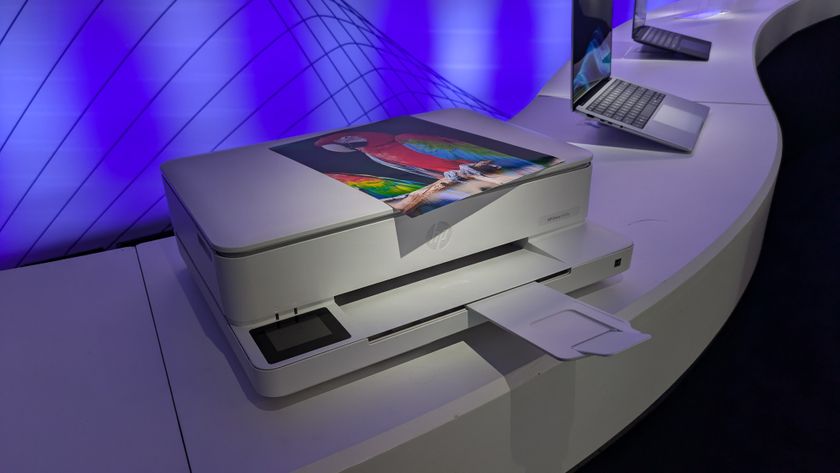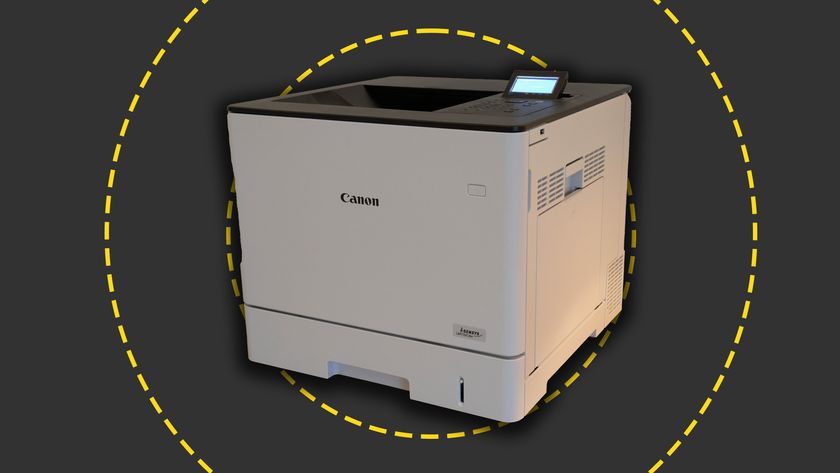Xerox says the solid-ink system allows lower running costs and produces up to 90 per cent less waste than an equivalent laser printer. There are some clear advantages including the comparative ease of storing large stocks of consumables and the unique ability to 'top-up' a printer which has yet to run out of ink.
However, there are disadvantages to the system as well. The ink must be melted and kept molten to print. It takes takes 12-minutes for the printer to warm-up from a cold start. And if you ever need to move the ColorQube, you have to switch it off and wait 30 minutes for the ink to cool. While the 8900 uses significantly less power than a comparable laser when printing, it uses more on standby: the minimum we measured was 37 watts.
Colour reproduction
Unlike a laser printer, the solid ink system uses fixed heads to lay ink down on the page surface, producing strong results irrespective of media type and colour. Prints have a rich, glossy sheen. Graphics looked superb, but we were less impressed with the quality of black text, which had a shaky outline visible to the naked eye.
Under magnification it was clear the characters were composed of coloured dots, rather than pure black, which could be an issue in some exacting applications. We noticed a similar issue with mono photocopies, in which coloured dots are used for half toning providing excellent shade control but lending the page a grey-green tinge. Colour copies were superb, though.
Unable to scan from a PC, we tried to capture images directly to a memory stick, but the 8900 reported the USB scanning template was invalid. We could only scan to the MFP's public storage, from where images could later be retrieved via its web interface. The results, sent to PDF documents, were good enough for office applications.
Running costs
Xerox offers a hybrid pricing model for the 8900 in which pages of black text are charged at a typical rate of 0.6p ex VAT, even if they include a small amount of colour such as a Word document with a couple of embedded hyperlinks. Those with a bit more colour such as an embedded chart are charged at a higher rate of 3p, and graphics-rich pages cost 6p.
This compares favourably to the cost of buying consumables for the 8700. Using Xerox's ISO/IEC 19752 yield ratings, cost for this work out at around 5.2p per colour page and a steep 1.4p ex VAT for a black page. The two pricing models, based on different standards, aren't directly comparable. However, they do suggest the lower running costs would offset the higher purchase price of the 8900 within a year for those printing two reams of mixed black and colour pages each week.
Verdict
There's a lot to like about the ColorQube 8900 and the solid ink system at its heart. The printer is capable of excellent, rich graphics, has low running costs and is paired with what appears to be a quality scanner. We were frustrated by the driver issues we experienced prevented us getting the best from it. The modest review score reflects our experience, but with a working installer and scan interface it's likely that we would have awarded at least another star.
Print capability: 2,400dpi, solid ink printing. PCL6 and PCL5c emulation, PostScript 3, JPEG, PDF, TIFF and XPS Speed: 44ppm mono/44ppm colour Duty: 120,000 images/month (max), 2,000-15,000 (recommended) Paper handling: Input 525-sheet tray plus 100-sheet bypass tray, output 350-sheet tray, 50-sheet ADF Interfaces: USB, 10/100 Mbit Ethernet, Supported operating systems:Windows Server 2003/2008, Windows XP/Vista/7, OS X 10.5 or later, Fedora Core 12-15, HP-UX 11i v2, IBM AIX 5, Redhat Enterprise Linux, SUSE, Solaris 9 and 10 Power consumption: Sleep 37W, Standby 160W, Active 606W Size: 605x594x615mm Weight: 46kg [Benchmarks] TTFP: 25s (default) Document speed: 19.7ppm (default) Graphics speed (colour):11.2ppm (default) Duplex speed (colour): 1m 34s (10 sides/5 pages) Cost per page: 0.6p (black) – 6.0p (colour)
After a brief career in corporate IT, Simon Handby combined his love of technology and writing when he made the move to Computer Shopper magazine. As a technology reviewer he's since tested everything from routers and switches, to smart air fryers and doorbells, and covered technology such as EVs, TVs, solar power and the singularity.
During more than 15 years as Shopper's long-time printer reviewer, Simon tried, tested and wrote up literally hundreds of home, small office and workgroup printers. He continues reviewing smart products and printers for a variety of publications, and has been an IT Pro contributor since 2010. Simon is almost never happier than when surrounded by printers and paper, applying his stopwatch and a seasoned eye to find the best performing, best value products for business users.













